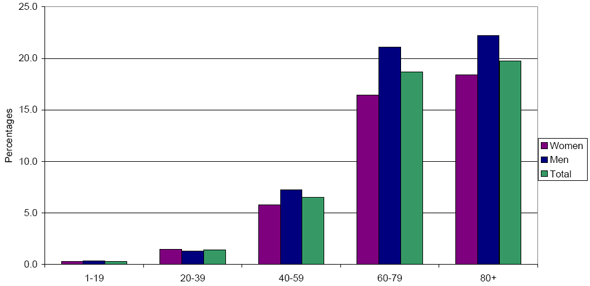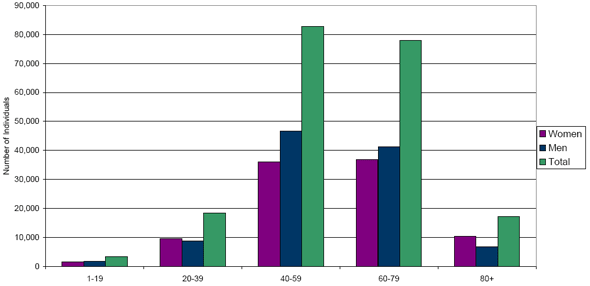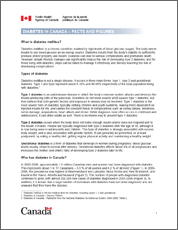Common menu bar links
Institutional links
Diseases & Conditions
Health & Safety
Research & Statistics
Agency Information
Search Box
E-mail this page
National Diabetes Fact Sheets Canada 2008
Diabetes in Canada - Facts and Figures
What is diabetes mellitus?
Diabetes mellitus1 is a chronic condition, marked by high levels of blood glucose (sugar). The body needs insulin to use blood glucose as an energy source. Diabetes results from the body's inability to sufficiently produce and/or properly use insulin. Diabetes can lead to serious complications and premature death. However, simple lifestyle changes can significantly reduce the risk of developing type 2 diabetes, and for those living with diabetes, steps can be taken to manage it effectively and thereby lowering the risk of developing complications.
Types of diabetes
Diabetes mellitus is not a single disease; it occurs in three main forms: type 1, type 2 and gestational diabetes. Type 1 and type 2 represent about 5-10% and 90-95% respectively of the total population living with diabetes.2
Type 1 diabetes is an autoimmune disease in which the body's immune system attacks and destroys the insulin-producing cells of the pancreas. Scientists do not know exactly what causes type 1 diabetes, but they believe that both genetic factors and exposure to viruses may be involved. Type 1 diabetes is the most severe form of diabetes, typically striking children and youth suddenly, making them dependent on injected insulin for life, and carries the threat of complications such as kidney failure, blindness, nerve damage, amputations, heart attack and stroke. While diagnosis most often occurs in childhood and adolescence, it can strike adults as well. There is no known way to prevent type 1 diabetes.
Type 2 diabetes occurs when the body does not make enough insulin and/or does not respond well to the insulin it makes. People are typically diagnosed with type 2 diabetes after the age of 40, although it is now being seen in adolescents and children. This type of diabetes is strongly associated with excess body weight, and is also associated with genetic factors. It can generally be prevented, or at least postponed, by eating a healthy diet, getting regular physical activity and maintaining a healthy weight.
Gestational diabetes is a form of diabetes that develops in women during pregnancy. Blood glucose levels usually return to normal after delivery. Gestational diabetes affects about 4% of all pregnancies and increases the mother and child's risks of developing type 2 diabetes later in life.
Who has diabetes in Canada?
In 2005-2006, approximately 1.9 million Canadian men and women had been diagnosed with diabetes. This represents about 1 in 17 Canadians - 5.5 % of all women and 6.2 % of all men3 (Figure 1). In 2005-2006, the prevalence was highest in Newfoundland and Labrador, Nova Scotia and New Brunswick, and lowest in the Yukon, Alberta and Nunavut (Figure 2). The number of people with diagnosed diabetes continues to grow, with almost 200,000 new cases of diabetes diagnosed in 2005-2006 (Figure 3). In addition, it is known that a large number of individuals with diabetes have not been diagnosed and are unaware that they have the disease.
Older Canadians are more likely to have diabetes. In 2005-2006, twenty-two percent of people (approximately 1 in 5) in the 75-79 year old age group had been diagnosed with diabetes. This was almost ten times the proportion seen in Canadian adults aged 35-39 where the prevalence was 2.3%, or 1 in 434 (Figure 1)
Overall, in adults aged 20 and older, death rates for those with diabetes are two to three times greater than those of the general population. Among 20-39 year olds, individuals with diabetes die at a rate more than six times that of the general population, while in the 60-79 year age group the rates are about twice as high (Figure 4).

Source: Public Health Agency of Canada, using NDSS data files contributed by provinces and territories, as of August, 2008
*Data for Nunavut were unavailable.

Source: Public Health Agency of Canada, using NDSS data files contributed by provinces and territories, as of August, 2008
*Data for Nunavut were unavailable.
‡The 95% Confidence Interval shows an estimated range of values which is likely to include the true prevalence rate 19 times out of 20.
*Age-standardized to 1991 Canadian population

Source: Public Health Agency of Canada, using NDSS data files contributed by provinces and territories, as of August, 2008
*Data for Nunavut were unavailable.
‡The 95% Confidence Interval shows an estimated range of values which is likely to include the true prevalence rate 19 times out of 20.
*Age-standardized to 1991 Canadian population

Source: Public Health Agency of Canada, using NDSS data files contributed by provinces and territories, as of August, 2008
*Data for Nunavut were unavailable.
High Risk Populations
Research has shown that Aboriginals and certain populations, such as Asians, Hispanics, and Africans, have a significantly higher risk of developing diabetes. Estimates of the prevalence of diabetes in Aboriginal people have been found to be as much as 3 to 5 times that in non-Aboriginal populations.
The Cost of Diabetes
- Individuals and families bear the cost of diabetes through medical expenses, inconvenience and deteriorating health. These personal burdens translate into significant costs for Canadian society as a whole.
- With the aging of Canada's population, the total direct health care costs associated with diabetes is expected to increase to over $8 billion annually by 20165.
Finding Additional Information and Support
For general help and support about types 1, 2 and gestational diabetes in your province, please visit the Canadian Diabetes Association (www.diabetes.ca ![]() ) or Diabète Québec (www.diabete.qc.ca
) or Diabète Québec (www.diabete.qc.ca ![]() )
)
For information specific to type 1 diabetes, please visit the Juvenile Diabetes Research Foundation (www.jdrf.ca ![]() )
)
For information about renal or kidney-related diseases and complications, please visit the Kidney Foundation of Canada (www.kidney.ca ![]() )
)
For information about blindness or vision-related diseases and complications, please visit CNIB (www.cnib.ca ![]() )
)
For information about research on diabetes, obesity, nutrition and metabolic disorders, please visit the Canadian Institutes of Health Research - Institute of Nutrition, Metabolism and Diabetes (www.cihr.ca ![]() )
)
For information on the Canadian Diabetes Strategy, please visit the Public Health Agency of Canada (www.diabetes.gc.ca ![]() )
)
For information on the Aboriginal Diabetes Initiative, please visit Health Canada
(http://www.hc-sc.gc.ca/fniah-spnia/diseases-maladies/diabete/index-eng.php ![]() )
)
Acknowledgements
The following organizations collaborated in compiling the information for this fact sheet:
- Canadian Diabetes Association
- Canadian Institutes of Health Research
- CNIB
- Diabète Québec
- Juvenile Diabetes Research Foundation Canada
- Public Health Agency of Canada
- The Kidney Foundation of Canada
- Diabetes mellitus is the full medical term for diabetes, including types 1, 2 and gestational
- Diabetes in Canada - Second Edition
- Diabetes in Canada: Highlights from the National Diabetes Surveillance System 2004-2005. Table 2.
- Diabetes in Canada: Highlights from the National Diabetes Surveillance System 2004-2005. Table 2.
- Based on Ohinmaa A et al, "The projection of prevalence and cost of diabetes in Canada:2000-2016", Can J Diabetes 2004 28(2) 1-8

